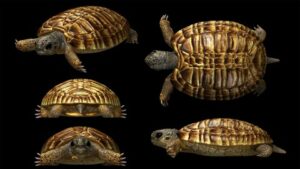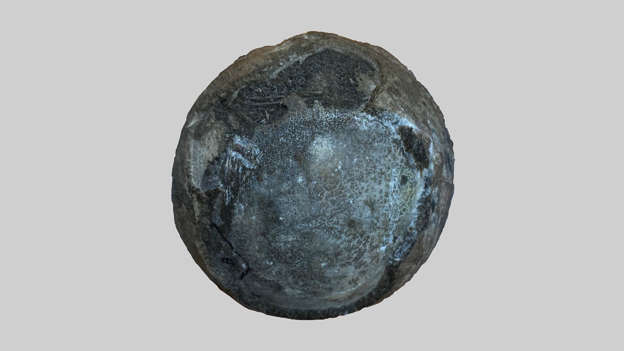The eggshell was unquestionably thick.
Around 90 million years prior, a monster turtle in what is currently focal China laid a grasp of tennis ball-size eggs with amazingly thick eggshells. One egg never incubated, and it stayed undisturbed for a huge number of years, saving the fragile bones of the undeveloped turtle inside it.
In 2018, a rancher found the egg and gave it to a college. Presently, another examination of this egg and its uncommon undeveloped organism denotes the first occasion when that researchers have had the option to recognize the types of a dinosaur-age early stage turtle.
This example additionally reveals insight into why its species, the earthbound turtle Yuchelys nanyangensis, went terminated 66 million years prior toward the finish of the Cretaceous time frame, when the dinosaur-killing space rock struck Earth. The thick eggshell permitted water to infiltrate through, so grasps of eggs were possible covered in homes profound underground in sodden soil to hold them back from drying out in the parched climate of focal China during the late Cretaceous, the analysts said.
While these turtles’ exceptional earthly way of life, thick eggs and underground settling procedure might have served them well during the Cretaceous, it’s conceivable that these specific turtles couldn’t adjust to the cooler “climatic and natural changes following the end-Cretaceous mass termination,” study co-specialist Darla Zelenitsky, a partner teacher of paleobiology at the University of Calgary in Canada, revealed to Live Science.
Egg-cellent revelation
The rancher found the egg in Henan territory, a district popular for the large number of dinosaur eggs individuals have found there in the course of recent years, Zelenitsky said. In any case, in examination with dinosaur eggs, turtle eggs — particularly those with protected incipient organisms — seldom fossilize in light of the fact that they’re so little and delicate, she said.
The Y. nanyangensis egg, notwithstanding, endured on the grounds that it’s a tank of an egg.
At 2.1 by 2.3 inches (5.4 by 5.9 centimeters) in size, the almost round egg is somewhat more modest than a tennis ball. That is bigger than the eggs of most living turtles, and somewhat more modest than the eggs of Galápagos turtles, Zelenitsky said.
The eggshell’s 0.07 inch (1.8 millimeters) thickness is likewise amazing. To place that in context, that is multiple times thicker than a Galápagos turtle eggshell, and multiple times thicker than a chicken eggshell, which has a normal thickness of 0.01 inch (0.3 mm). Bigger eggs will in general be thicker, similar to the 0.08-inch-thick (2 mm) ostrich eggshell, yet “this egg is a lot more modest than an ostrich egg,” which normal around 6 inches (15 cm) long, Zelenitsky said.
A condition that utilizations egg size to anticipate the length of the carapace, or the top piece of the turtle’s shell, uncovered that this thick egg was reasonable laid by a turtle with a 5.3-foot-long (1.6 meters) carapace, the specialists found. That estimation does exclude the length of the neck or head, so the mother turtle was effectively as long as certain people are tall.

Destined egg
The scientists utilized a miniature CT output to make virtual 3D pictures of the egg and its incipient organism. By contrasting these pictures and a remotely related living turtle species, apparently the incipient organism was almost 85% created, the scientists found.
Some portion of the eggshell is broken, Zelenitsky noted, so “perhaps it attempted to bring forth,” yet fizzled. Obviously, it wasn’t the lone early stage turtle that didn’t make it; two recently found thick-shelled egg grips from Henan territory that date to the Cretaceous — one with 30 eggs and another with 15 eggs — likely likewise have a place with this present turtle’s currently terminated family, known as Nanhsiungchelyid, the analysts said.
Turtles in this family — family members of the present stream turtles — were exceptionally level and developed to live totally ashore, which was extraordinary during that time, Zelenitsky said.
The investigation of the recently discovered egg is exceptional for its virtual 3D examination of the undeveloped organism, which aided lead to its species finding, said Walter Joyce, an educator of fossil science at the University of Fribourg in Switzerland, who was not engaged with the examination. Besides, this investigation offers proof that Nanhsiungchelyid turtles were “adjusted to living in cruel, earthly conditions, yet laid their huge, thick-shelled eggs in shrouded homes in soggy soil,”.
Disclaimer: The views, suggestions, and opinions expressed here are the sole responsibility of the experts. No Unique Analyst journalist was involved in the writing and production of this article.

